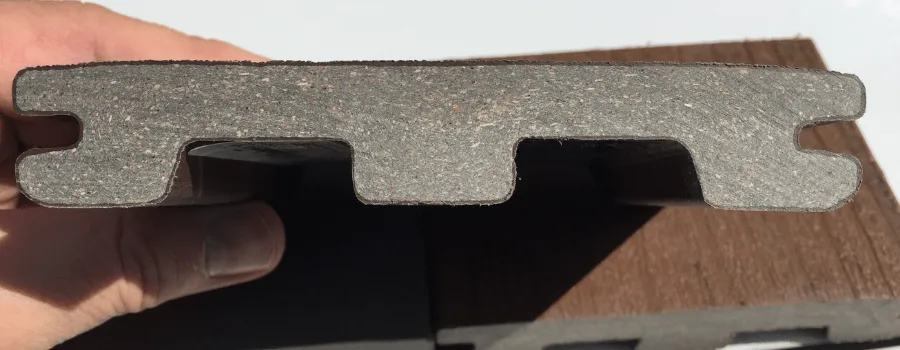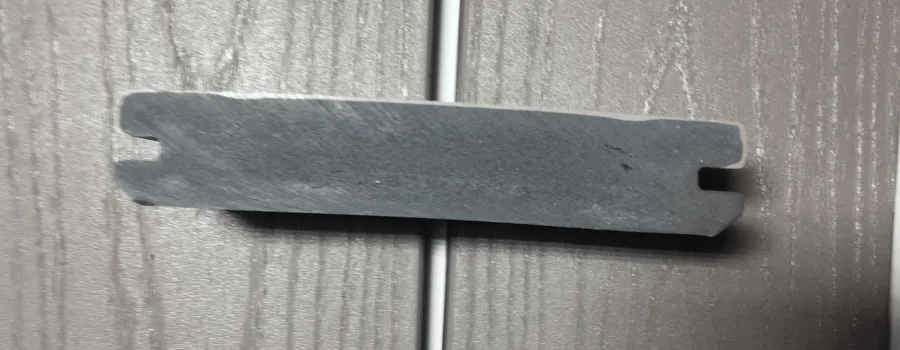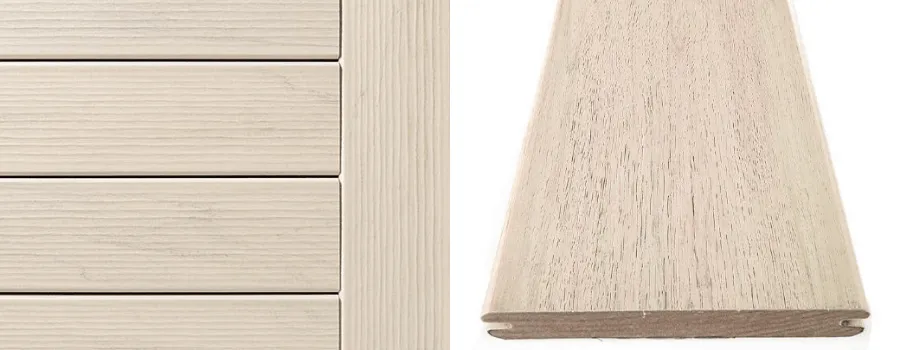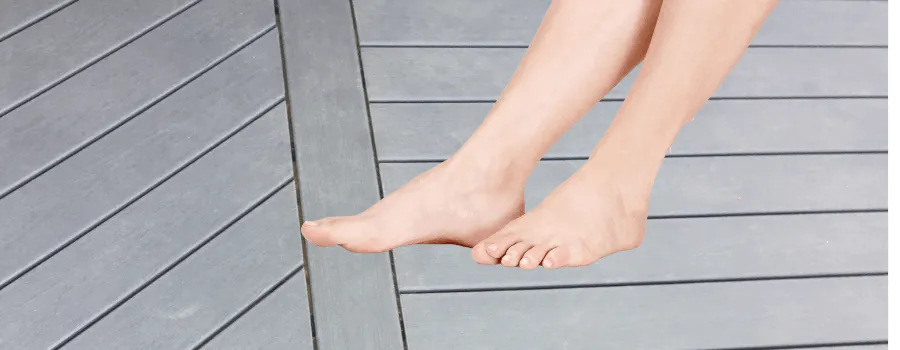A common complaint about composite decking is it gets hot in the sun. This was especially true with earlier generations of composite decking. They were uncomfortably hot. Hot to walk on. Hot to the touch and just overall a very hot decking board.
With the evolution of synthetic decking, manufactures started producing PVC decking. The largest drive was to make a better decking than composite that would last longer while still requiring little maintenance. But along with increasing the decking expected life, PVC decking also has some distinct advantages over composite decking.
One of the advantages of PVC decking over composite decking is it is cooler . PVC is a cooler decking board both to the touch, along with the core of PVC decking is less dense, holding less heat than most composite decking boards.
. PVC is a cooler decking board both to the touch, along with the core of PVC decking is less dense, holding less heat than most composite decking boards.
Before discussing the advantages of PVC decking over many composite deck boards, we need to define terms. Define decking, including PVC decking and what defines composite decking.
The clarity in terms is important, as I have talked with many homeowners and even salespeople about decking, but as the conversation progresses, it becomes clear we are no longer talking about composite decking but rather PVC decking, often grouped with composite decking but is not the same.
To be fair, for many years, PVC decking was sold as a new generation of composite decking and is still displayed and sold along side composite decking. But when we are discussing the differences between composite and PVC decking performance, in particular, if PVC decking is cooler than composite, we need to be clear of what we are talking about.
performance, in particular, if PVC decking is cooler than composite, we need to be clear of what we are talking about.
Trex was the one of the first to introduce the world to composite decking and was soon followed by TimberTech
was the one of the first to introduce the world to composite decking and was soon followed by TimberTech another dominate manufacture in composite decking. They both have their own distinct methods and recipes for their composite decking. Both have significantly improved their decking lines over the years creating composite decking that is better to work with. While still providing years of low maintenance deck enjoyment. This evolution has led to improved decking but also the introduction of PVC decking as an alternative.
another dominate manufacture in composite decking. They both have their own distinct methods and recipes for their composite decking. Both have significantly improved their decking lines over the years creating composite decking that is better to work with. While still providing years of low maintenance deck enjoyment. This evolution has led to improved decking but also the introduction of PVC decking as an alternative.
What is Composite Decking?
Composite decking is a mixture of plastic and organic fibres blended and extruded into decking boards. The organic fibres provide strength to the decking, and the plastic protecting the fibres from moisture, reducing rot. Most quality composite decking boards are also wrapped with a polymer cap that improves its appearances and helps to protect the decking core from water and minimize mould and mildew growth.

To further complicate things, companies vary in what organic material they blend with plastic. The predominant blend material is wood fibres, which a majority of composite decking is made of. But there are some exceptions, Deckorators® is a mineral-based composite decking, for reasons we will not get into here. Cali decking
is a mineral-based composite decking, for reasons we will not get into here. Cali decking also produces a bamboo-based composite decking.
also produces a bamboo-based composite decking.
To oversimplify, composite decking is any synthetic decking that combines plastic and another type of material. For now, we will ignore with what and why but stay focus that composite decking is composed of multiple materials.
Now before answering why PVC decking is cooler than composite decking.
What is PVC Decking?
First, PVC is short for polyvinyl chloride, often called “vinyl.” A very common building material for pipes, window frames and even parts of your car. But for our focus, the biggest difference between composite decking and PVC decking is the core of the decking is not a blend of material. PVC decking’s core is strictly polyvinyl chloride, without the addition of any other material.
Like many composite deck boards, PVC decking also has a polymer cap to protect the core material of the deck and improve its appearance. This is why often why the two deck boards types are grouped together. From a quick glance, they look very similar, if not exactly the same.

Both with similar caps, our focus in comparison is the core of the decking. Does the material blended in composite decking make it hotter than the polyvinyl chloride core of PVC decking?
decking?
Before going any further, we need to clear up one more thing about decking getting hot.
All Decking, PVC, Composite and Wood Will Get Hot in the Sun
All decking will be hot to the touch. Steps can be taken to reduce the decking temperature, but it will still be hot to the touch. Meaning that regardless if your decking is PVC or composite, it will be hot in the sun.
This is mostly to do with the science of heat and reflection. Decking is a flat surface reflecting the sun’s heat more than cool grass in your yard. Making the decking hotter in the sun than any where in your yard.
A little aside, but the benefit of having grass in your yard. The Lawn Institute research has shown a healthy grass yard has a maximum temperature of 88°F (31 °C), which is considerably cooler than the decking heat in the sun. This is why it’s so refreshing to run through lush green grass.
research has shown a healthy grass yard has a maximum temperature of 88°F (31 °C), which is considerably cooler than the decking heat in the sun. This is why it’s so refreshing to run through lush green grass.

Just another reason to surround your deck with vegetation. Not only grass but flowers and trees. The leaves not only providing shade but will also cool the air around and on your deck.
So, regardless of what decking you choose, you will need to take steps to reduce the heat in the summer. Decks are great for enjoying summer days, but they will get hot. Without additional accessories to reduce the temperature of the deck. For recommended deck comfort and cooling accessories, click here.
Now back to selecting the right decking for your summer deck, should it be composite or PVC.
Almost All of Azek “Stays Cooler” Decking Boards are PVC
This is no fluke, that of all the decking that TimberTech and Azek offer that most of their cooler boards are PVC. All except Whitewash Cedar™
offer that most of their cooler boards are PVC. All except Whitewash Cedar™ which is a composite but is practically white. The colour of your decking makes a big difference in heat, but we will get to that more later. The rest are all from their Harvest Collection® and Vintage Collection® which are PVC based decking boards. A cooler decking material compared to most composite decking.
which is a composite but is practically white. The colour of your decking makes a big difference in heat, but we will get to that more later. The rest are all from their Harvest Collection® and Vintage Collection® which are PVC based decking boards. A cooler decking material compared to most composite decking.
“Up to 30 degrees [17°C] cooler than many competitive composite products.”
Azek
In the summer sun, that’s a big temperature difference. Going from the deck is too hot to walk on, to its nice and warm out on the deck. That’s the difference that PVC decking can make for your deck.
This is no accident that PVC is rated as a cooler decking than most composite decking . We say most because there are some exceptions.
. We say most because there are some exceptions.
Composite Decking Designed to be Cooler.
One exception for hot composite decking is MoistureShield . They have designed several of their composite boards to be cooler in the sun than competitive composite decking. They are reducing the temperature of their composite decking with their patent CoolDeck® Technology.
. They have designed several of their composite boards to be cooler in the sun than competitive composite decking. They are reducing the temperature of their composite decking with their patent CoolDeck® Technology.
“Helps create more comfortable outdoor living environments by reducing heat by up to 35%”
CoolDeck® Technology
Slight different reference point than Azek PVC decking. MoistureShield promising cooler decking boards by percentage points. Were Azek holds out a maximum possible temperature difference between PVC decking and comparative composite decking. Both promising cooler decking but without a clear measure for comparison.
With MoistureShield composite decking with CoolDeck® Technology is currently limited to three colours, Cathedral Stone, Mochaccino and Cold Brew, which are intentionally lighter. Absorbing less heat, decreasing the temperature of the decking.
Which leads us to our next point for cooler decking.
The Colour of PVC Decking Impacts How Hot They Are
I have the joy of raising four kids . Each with a similar experience in elementary school. They come to me all excited about what they have learned. Black is hotter than white. Sometimes to the extreme that they asserted, insisting that they don’t need a jacket on a cold winter day because they are wearing a black shirt.
. Each with a similar experience in elementary school. They come to me all excited about what they have learned. Black is hotter than white. Sometimes to the extreme that they asserted, insisting that they don’t need a jacket on a cold winter day because they are wearing a black shirt.
The same is true with both composite and PVC decking. The darker the colour, the hotter the decking. Lighter the colour, the cooler in the sun. Basic science.
TimberTech Pro Whitewash Cedar™ is a great example, an almost white composite decking that is cooler in the sun. Being lite in colour, basically white, it promises to be a cool deck board. Better for enjoying with bare feet.

But we don’t all want white decking. That’s a little too extreme.
This is where TimberTech Azek PVC decking comes in. Offering much more diversity in decking colours but still being cooler being PVC decking. But even with PVC decking, lighter colour boards are also cooler boards. PVC may be a cooler material, but the colour further lowers the temperature. Allowing more bare feet in the summer heat.
Of their Vintage Collection®, they recommend Coastline®, Weathered Teak® and Cypress® as cooler deck boards. All three are lighter deck boards, helping to make them cooler.
It is not only the colour that makes the difference for the Vintage® and Harvest® collections when walking on but also the material. Made with a PVC core for cooler boards. Making cooler decking, cooler feet.
The Science of Why PVC is Cooler Than Composite Decking
Now that we have talked through some specific cooler decking boards both in PVC and composite decking designed to be cooler, let’s move to the science. A little disclaimer before we get started, comparing how hot the basic material of decking gets.
Even though this is helpful, it is only partially helpful. Just like gramma’s secret bread recipe that separates her bread from all others, the same is true with synthetic decking. Every manufacture of both PVC and composite decking have their own unique blend that differentiates them from the rest. But this also makes that we are not comparing apples to apples.
As we discussed, some composite decking is designed to be cooler, despite being made from wood and High-density polyethylene (HDPE). Being a synthetic product that involves chemistry. They can cook up things in their labs that may behave very differently than “standard” material. That being said let’s talk about the science of decking.

Wait, one more thing. I am a carpenter building decks, not a chemist. There are some nerdy things I am trying to understand to build better decks, but I will be the first to admit I may not grasp all that is included with the science. But I still feel it look straightforward enough to see why some decking is cooler than others.
There are three reasons why PVC decking is cooler than composite or treated pine decking.
| Property | Rigid PVC | Pine Wood | HDPE |
| Density | 1300–1450 kg/m3 1 | 537 – 626 kg/m3 3 | 940 kg/m3 4 |
| Thermal Conductivity | 0.14–0.28 W/(m·K)1 | With grain 0.22 W/(m·K) 2 Perpendicular to grain 0.14 W/(m·K) 2 | 0.44 W/m 4 |
| Heat Capacity | 840 – 1170 J/kg-K 5 | 2,300 J/kg-K 3 | 1330 to 2400 J/kg-K 4 |
Let’s talk these out. Comparing these three properties of decking, density, thermal conductivity and heat capacity. Starting from the bottom and working our way up.
Comparing Heat Capacity of PVC, Composite (HDPE) and Treated Pine Decking.
This is the easy win for PVC decking. Kilogram for Kilogram, Pound for Pound PVC decking simply cannot hold as much heat as the others. Even on the higher end, it holds half the heat of pine decking and almost the same with High-density polyethylene (HDPE), the stuff that composite decking is made of.
Now admittedly, composite decking is not solely made of HDPE but is also blended with other materials, wood fibres being the most common. But all that does is increases the heat capacity of the composite decking. Making composite decking hot to the touch even longer.
Which is what we are comparing in heat capacity. How long will the decking remain hot? How much heat will the decking transfer to your feet and air around it? This is one of the positive and noticeable differences between composite and PVC decking.

A change as small as a passing cloud shading the decking can quickly lower the PVC decking temperature. Going from warm to cool in seconds. Where other material may take minutes or even hours to cool down. Walking past a brick wall in the cool of the evening, and you can feel the warmth radiant from the wall, not so with PVC decking. As soon as the sun goes down or the temperature drops, so will PVC decking’s warmth.
But heat capacity is only part of the story. Like our brick wall radiating heat long after the sun has gone down. It is not unusual for concrete and bricks to feel cool to the touch, even during the midday sun. One it takes more to warm up the concrete with its high heat capacity.
This is where our five-minute heat test of decking can be a little misleading. Taking the decking out into the sun for five-minute before reading their temperature will make PVC decking hotter than composite and wood decking. Not because it is ultimately a hotter decking but because it increases in temperature quicker.
Or let’s put it this way. If I had 10 000 Kelvins to warm my deck. I could raise PVC temperature almost 12 degrees but only a little over 4 degrees with treated pine and possibly the same or more with composite decking. With the same energy or time is the sun. It takes less to heat up PVC decking, but it will burn less when walked on.
But this is only part of the story. We also need to consider how quickly heat transfers or doesn’t.
How Quickly Does PVC, Composite or Treated Decking Transfer Heat?
Or in other words, how soon will you be running off the deck after you step out unto the deck in the sun with bare feet?
In some ways this matters more then how hot the actual material gets because this is what you will feel. It really doesn’t matter how hot the decking is. It matters how hot it makes you feel.
Here composite decking with High-density polyethylene is the clear loser, burning your feet in half the time as treated wood decking. Before you can say ouch standing on wood you will be dancing off composite decking .
.

Between PVC and composite decking, the difference is similar. PVC decking may get hot faster, but it will take longer to burn you. Almost as long as wood decking, but with some variation. PVC decking will not feel as hot as composite decking to the touch. Which is a good thing when you’re out enjoying the sun.
But this is only part of the story. We still need to discuss decking’s density.
Comparing the Density of PVC, Composite and Treated Decking Concerning Heat
Decking density matters when comparing how cool the decking is because how heavy the decking is determines how much heat can be absorbed by the decking. Most decking is 1″ (25mm) thick. It can vary a little between brands but is a good working number.
When we were discussing decking heat capacity, it was based on weight. Meaning the heavier the decking is, the more heat it can hold. The more decking you are standing on.
Now, this is where our material comparison really fails us. If you have worked with any amount of decking, you know that composite is the heaviest. Depending on how wet the treated decking is, of which is heavier PVC or treated. But PVC decking is always light as like a feather compared to composite.
This became crystal clear to me this summer when I went from building a composite deck to finishing a deck with PVC decking. That is two different materials. One I was struggling to move the decking the other they were flying around. PVC decking is that much lighter.
But that’s not what the chart shows. In our comparison of material, PVC is clearly heavier than both wood and composite decking. Significantly heavier! So, what gives?
Why does our chart not work?
This is a matter of the manufacturing process. How PVC decking being extruded changes the density of the decking, in a good way. Now I cannot explain the science, but I can assure you that PVC decking is less dense than composite decking.
Fortunately, you don’t need to, just trust me with this one. Azek is here to help. The CCMC 13690-R report rates Azek PVC decking density at 661 kg/m3. Making is similar to treated pine and significantly lighter than composite decking. On top of this, unlike wood that absorbs water and increases in weight and heat capacity. PVC remains the same as the day you installed it.
report rates Azek PVC decking density at 661 kg/m3. Making is similar to treated pine and significantly lighter than composite decking. On top of this, unlike wood that absorbs water and increases in weight and heat capacity. PVC remains the same as the day you installed it.
A little aside to better compare the two deckings. It is not uncommon for composite decking to be scalloped. In which grooves are formed on the underside of the decking, reducing the amount of material. With two benefits, lower cost but also the heat capacity of the decking. With less decking heating up under your feet. Which again can change our equation for which decking is coolest.
Which brings us to our finally variable in cooler decking.
Under Deck Ventilation Cools Down Decking
There are many reasons to ensure that there is proper ventilation under your deck . But for our focus, sufficient ventilation will cool down the decking and deck.
. But for our focus, sufficient ventilation will cool down the decking and deck.
This is more helpful with lower decks, one less than 2′ (0.6m) from the ground. Utilizing the cooling effect of both shade and heat-absorbing ground cover material .
.
The shade created by the decking naturally makes the air cool under the deck. Proximity to the cool earth or, even better, drain rocks that absorb heat from the midday sun. Creating a cooler space under the deck.
The cold air under the deck will help cool the deck boards, with the bottom of the deck boards drawing heating out of the deck boards. Working for both PVC and composite decking, even wood.
But ventilation can do even more with this cool air.
The deck’s side ventilation helps to push this cool air out from under the deck up through the gaps between the deck boards. Creating a natural air conditioner. With the hot air around the deck squeezing the cool air under the deck. Pushing the cool air out between the deck boards’ gaps, cooling the deck with cool air from under the deck.
Sources for Material Comparison
